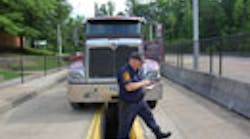Despite more inspectors operating out of more locations across the U.S., Canada, and Mexico for the 72-hour Roadcheck 2009 safety blitz, held earlier this month, out-of- service (OOS) rates for commercial trucks and buses continued to drop. That’s a very encouraging sign, according to Steve Keppler, director of policy and programs for the Commercial Vehicle Safety Alliance (CVSA), the main sponsor of the annual Roadcheck event.
“It shows we’re on a good trend line here in terms of safety,” Keppler told FleetOwner. “If you look over the last several years of data, you’ll see a steady decline in OOS rates despite a bigger and wider inspection presence. The takeaway from our perspective is that the [trucking] industry is getting more proactive about safety.”
Over 9,700 CVSA and Federal Motor Carrier Safety Administration (FMCSA) certified inspectors stationed at 2,148 locations across North America performed 72,782 truck and bus inspections, which included 57,013 North American Standard (NAS) Level 1 inspections. Those numbers represent significant increases over records set last year, with total inspection and NAS Level 1 outputs 7.1% and 8.9% higher, respectively, compared to 2008.
The key numbers indicating that commercial vehicle safety is improving encompass both drivers and equipment, noted Keppler. Out of all inspections, 95.6% of the drivers passed – the highest passage rate ever attained over Roadcheck’s 22 year history. Only 4.4% of the drivers were placed out of service compared to 5.3% last year. For NAS Level 1 inspections, 96.1% of drivers passed, with just 3.9% placed out of service, compared to a 4.9% driver OOS rate in 2008.
In terms of commercial vehicles, 80.4% passed with 19.6% placed out of service – the lowest OOS rate posted since 1996 – compared to 20.8% in 2008. Out of all NAS Level 1 inspections, 77.8% of vehicles passed and 22.2% were placed out of service, compared to 23.9% last year.
“The commercial motor vehicle industry is proving the old adage that it pays to be safe,” said Darren Christle, CVSA president. “If you look at the data it clearly shows when carriers prepare for safety they benefit not only by avoiding fines, but by saving lives. It can be said that Roadcheck 2009 saved 17 lives and helped to avoid 307 injuries. Over the course of an entire year that equals 2,068 lives saved and 37,352 injuries avoided. By any measure those are big numbers, and the enforcement community should be proud of its accomplishments in this regard.”
State motor carrier agencies stressed that even though the Roadcheck event is well publicized ahead of time, it still remains a very effective enforcement effort.
“Although inspectors perform this type of work every day, intensive inspection operations like Roadcheck help reinforce the message that safety is our number- one priority,” said Howard Russell, field manager with Oregon’s Dept. of Transportation Motor Carrier Transportation Div.. “It’s important to understand that the inspections conducted are not random inspections. Rather, we scrutinize drivers and trucks using several sorting tools and select those who are more likely to be out of compliance.”
Roadcheck’s data also indicated that the number of commercial motor vehicle drivers wearing safety belts improved by more than 22% over last year – another positive safety indicator that drew praise from FMCSA Acting Deputy Administrator Rose McMurray.
“The positive results of this year's Roadcheck program reinforce the importance of federal, state and local enforcement partners working together to keep our roads safe and save lives,” McMurray noted. “The data shows that on key measures of safety performance, such as driver and vehicle compliance with safety requirements and seat belt usage, the commercial motor carrier industry is demonstrating record improvements.”



